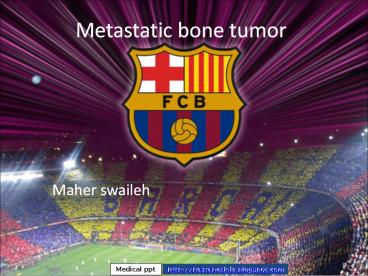Metastatic bone tumor - PowerPoint PPT Presentation
Title:
Metastatic bone tumor
Description:
Metastatic bone tumor Maher swaileh Medical ppt http://hastaneciyiz.blogspot.com Metastatic Disease Most common malignant lesion of bone. approximately 50 percent of ... – PowerPoint PPT presentation
Number of Views:368
Avg rating:3.0/5.0
Title: Metastatic bone tumor
1
Metastatic bone tumor
- Maher swaileh
Medical ppt
http//hastaneciyiz.blogspot.com
2
Metastatic Disease
- Most common malignant lesion of bone.
- approximately 50 percent of tumors can spread or
metastasize to the skeleton. - Bone is the third favorite place for metastatic
cancers after lung and liver . - More than 1.2 million new cases are diagnosed
each year - Typically multifocal BUT renal and thyroid
carcinomas produce only a solitary lesion.
3
- Malignant lesions are more likely to be in axial
bones. - Common sites for metastasis are the vertebrae,
pelvis, proximal parts of the femur, ribs,
proximal part of the humerus, and the skull. More
than 90 of metastases are found in this
distribution. - metastases to the bones of the hands and feet are
rare , but 50 metastases to hand and feet
originate from lung neoplasms .
4
- Bone metastases to the finger. Radiograph shows a
destructive expanded osteolytic lesion in the
metacarpal of the thumb in a 55-year-old man with
lung carcinoma.
5
Mets (adults)
- lytic
- Lung
- Kidney
- colon
- Thyroid
- blastic
- Prostate
- Stomach
- Bladder
Breast cancer cause both lytic and blastic
6
Typical x-ray appearance of osteolytic bone
metastases. This plain pelvic x-ray film of a
75-year-old patient with breast carcinoma shows
multiple osteolytic bone lesions. gtdecrease in
bone density .
7
typical x-ray appearance of osteoblastic bone
metastases. This plain pelvic x-ray film of a
patient with prostate cancer shows multiple
osteoblastic metastases to the pelvis and lumbar
(L4) and sacral (S1) vertebral bodies.gtincrease
in bone density
8
Mets (kids)
- NB( neuroblastoma)
- Wilms tumor
- OS (osteosarcoma).
- Ewings sarcoma
- Rhabdomyosarcoma
9
- (1) direct extension
- (2) retrograde venous flow
- (3) seeding with tumor emboli via the blood
circulation .
10
- presentation
- bone weakness which predispose to pathologic
fractures. - Pain which results in reduced mobility.
- Large bony lesions which causes palpable masses.
- neurologic impairment due to spinal epidural
compression. - Anemia (decreased red blood cell production) is a
common blood abnormality in these patients - Some patients have history of the primary
malignant tumor symptoms, BUT others did not
complain of anything before.
11
- Pathologic fracture. Radiograph shows a displaced
fracture through an osteolytic lesion in the
distal femur of a 53-year-old woman with lung
carcinoma.
12
- Spinal epidural compression in a 70-year-old man
with leg weakness. Lateral lumbar myelogram shows
a complete epidural block due to a destructive
osteolytic lesion of the L3 vertebral body.
Lumbar puncture was performed at the L2-3 level
13
- Approach to the patient
- History
- Physical examination
- Radiological studies e.g. Plain X-ray, MRI, CT
scan, Bone scan(radionuclide bone scanning
(Technetium-99m)). - Laboratory studies .
- Biopsy.
14
Radiological studies
- The presenting radiologic finding on X-ray is
often destruction of bone and/or lucent Lesions
of Bone. - Bone scan(radionuclide bone scanning
(Technetium-99m)) most cost-effective and
available whole-body screening test for the
assessment of bone metastases.
15
- (CT) and (MRI) are useful in evaluating
suspicious bone scintiscan findings that appear
equivocal on radiographs. - MRI can also help in detecting metastatic lesions
before changes in bone metabolism make the
lesions detectable on bone scintiscans. - CT scanning is useful in guiding needle biopsy,
particularly in vertebral lesions. - MRI is helpful in determining the extent of local
disease in planning surgery or radiation therapy.
16
(No Transcript)
17
(No Transcript)
18
(No Transcript)
19
(No Transcript)
20
X-ray
- RadioIsotope
Pt. presented with pain in the right upper thigh,
xray showing METS in upper 1/3 of
the femur, however radioisotope scan revealed
many deposits
in other parts of the skeleton.
21
- Treatment
- Can be divided into
- Systemic therapy, aimed at cancer cells that have
spread throughout the body, includes
chemotherapy, hormone therapy, and immunotherapy.
- Local therapy, aimed at killing cancer cells in
one specific part of the body, includes radiation
therapy and surgery.
22
- Treatment
- Treatment depends on the type of tissue involved
(which organ tissue type) - Radiation therapy, combined with selected
chemotherapeutic or hormonal agents, is the most
common treatment modality. - Early use of radiation and bisphosphonates (eg,
zoledronic acid, pamidronate) slows bone
destruction. - Some tumors are more likely to heal after
radiation therapy, such as blastic lesions of
prostate and breast, as compared to lytic
destructive lesions of lung and renal cell.
23
- Treatment
- Surgery is indicated mainly in case of fractures
or large metastatic mass. - If bone destruction is extensive, resulting in
imminent or actual pathologic fracture we may
need - surgical fixation
- resection and reconstruction
- Surgical intervention provide stabilization and
help minimize morbidity
24
Thank YouGood Luck
Medical ppt
http//hastaneciyiz.blogspot.com































